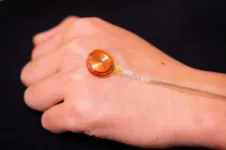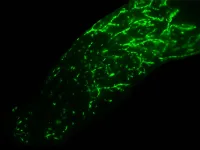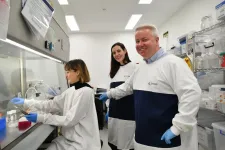(Press-News.org) By putting a piece of soft, strain-sensing sheet on the skin may be able to detect skin disorders non-invasively and in real-time very soon. A research team co-led by a scientist from City University of Hong Kong (CityU) has designed a simple electromechanical device that can be used for deep tissue pathology diagnosis, such as psoriasis, in an automated and non-invasive fashion. The findings will lay a foundation for future applications in the clinical evaluation of skin cancers and or dermatology diseases.
The research is co-led by Dr Yu Xinge, Assistant Professor from CityU's Department of Biomedical Engineering, and scientists from and Northwestern University in the US. Their findings have been published in the science journal Nature Biomedical Engineering, titled "Miniaturized electromechanical devices for the characterization of the biomechanics of deep tissue".
Electromechanical systems that enable precise, rapid measurements of the stiffness of soft tissues of the human body can provide useful clinical information for monitoring, diagnosing and treating various pathologies, particularly those of the skin. However, existing diagnostic evaluations, for example, magnetic resonance elastography, usually involve huge instruments at hospitals and trained practitioners. And the latest tissue stiffness-measuring technology based on sensing can only measure to superficial depths of upper skin, up to micrometre scale.
New device for real-time evaluations of deep tissue stiffness
To address the issue, the research team designed a simple, miniature electromechanical device for high-precision, real-time evaluations of deep tissue stiffness. The team used a miniature electromagnetic system that integrates a vibratory actuator and a soft strain-sensing sheet to monitor in real-time the Young's modulus, ie the tensile stiffness, of skin and other soft biological tissues at depths of approximately 1 to 8 mm, depending on the sensor designs.
The team evaluated the device's performance with a range of synthetic and biological materials, such as hydrogels, pigskin and on various parts of human skin. "The lesions exhibited higher stiffness than those of the nearby skin, primarily due to differences in skin elasticity and hydration. These simple measurements have potential clinical significance in rapidly identifying and targeting skin lesions, with capabilities that complement those of recently reported methods for sensing mechanical properties at tissue surface (typically micrometre-scale)," explained Dr Yu. He pointed out that cancer tissue is typically stiffer or softer than normal tissue, and such difference can be used as diagnostic biomarker for a range of skin conditions, like skin cancer or tumours under the skin.
A simple structure of the electromechanical device
The electromechanical device's thickness is only about 2.5 mm, and the contacting area is about 2 cm². It operated well on both hair-bearing and hairless areas of the skin. Its working mechanism is adapted from the basis of a skin-integrated haptic interface for virtual/augmented reality developed by Dr Yu and the collaborators from Northwestern University before.
The device works like this: after applying an alternating current through the copper coil, the magnet vibrates and creates pressures onto the bottom surface of the sensor. This would direct deformations that extend to millimetre-scale depths of tissue, which leads to periodic variations in electrical resistance. Analyses of these responses by simultaneously measuring the voltage allows quantitative determination of the stiffness of the tissues. Each measurement could be done within one minute.
The team then conducted clinical studies on patients with skin disorders with their newly invented electromechanical device. The results indicated a potential for accurate targeting of lesions associated with psoriasis, showing the practical medical utility of the device. "The data produced can assist in diagnosis, treatment tracking and disease monitoring particularly for skin associated disorders such as skin cancer, as well as in aspects of aesthetic dermatology and of the recovery from surface wounds," said Dr Yu.
Dr Yu also pointed out that their device has the potential to be used for the evaluation of skin physical properties under various conditions such as ageing, hydration loss or associated dermatological disorders. "In the near future, we believe this technology will allow people to monitor their skin health status anytime with a simple wearable device," said Dr Yu.
Dr Yu, together with Professor John A. Rogers, Professor Huang Yonggang and Dr Chang Jan-Kai from Northwestern University are the corresponding authors of the paper. Dr Song Enming, Senior Research Fellow in Dr Yu's group, and Professor Xie Zhaoqian, a former Senior Research Fellow in Dr Yu's group and now a Professor at the Dalian University of Technology, Professor Bai Wubin from University of North Carolina at Chapel Hill, and Dr Luan Haiwen from Northwestern University, are the first authors. Li Dengfeng, Yao Kuanming and Zhou Jingkun from CityU also participated in this research. Other researchers are from Northwestern Polytechnical University, The Pennsylvania State University, the University of Illinois at Urbana-Champaign, Sungkyunkwan University, Fudan University, and the Dalian University of Technology.
The research received funding support from including CityU, the National Natural Science Foundation of China, Fundamental Research Funds for the Central Universities, Ministry of Science and ICT of Korea, and National Science Foundation.
DOI number: 10.1038/s41551-021-00723-y
Detecting skin disorders based on tissue stiffness with a soft sensing device
2021-05-28
ELSE PRESS RELEASES FROM THIS DATE:
Revenge of the seabed burrowers
2021-05-28
New Haven, Conn. -- The ancient burrowers of the seafloor have been getting a bum rap for years.
These prehistoric dirt churners -- a wide assortment of worms, trilobites, and other animals that lived in Earth's oceans hundreds of millions of years ago -- are thought to have played a key role in creating the conditions needed for marine life to flourish. Their activities altered the chemical makeup of the sea itself and the amount of oxygen in the oceans, in a process called bioturbation.
But did that bioturbation help or hinder the expansion of complex animal life? A new Yale study, published in the journal Earth and Planetary Science Letters, found that ...
Ban on flavored vaping may have led teens to cigarettes, study finds
2021-05-28
New Haven, Conn. -- When San Francisco voters overwhelmingly approved a ballot measure banning the sale of flavored tobacco products in 2018, public health advocates celebrated. After all, tobacco use poses a significant threat to public health and health equity, and flavors are particularly attractive to youth.
But according to a new study from the Yale School of Public Health (YSPH), that law may have had the opposite effect. Analyses found that, after the ban's implementation, high school students' odds of smoking conventional cigarettes doubled in San Francisco's school district relative to trends in districts without the ban, even when adjusting for individual demographics and other ...
Electrons waiting for their turn: New model explains 3D quantum material
2021-05-28
This new 3D effect can be the foundation for topological quantum phenomena, which are believed to be particularly robust and therefore promising candidates for extremely powerful quantum technologies. These results have just been published in the scientific journal Nature Communications.
Dr. Tobias Meng and Dr. Johannes Gooth are early career researchers in the Würzburg-Dresdner Cluster of Excellence ct.qmat that researches topological quantum materials since 2019. They could hardly believe the findings of a recent publication in "Nature" claiming that electrons in the topological metal zirconium pentatelluride (ZrTe5) move only in two-dimensional ...
Open, expressive family life may reduce social deprivation effects among adopted children
2021-05-28
WHAT:
An environment in which family members support one another and express their feelings can reduce the effects of social deprivation on cognitive ability and development among adopted children, suggests a small study by researchers at the National Institutes of Health. In contrast, rule-driven households where family members are in conflict may increase an adopted child's chances for cognitive, behavioral and emotional difficulties.
The study was conducted by Margaret F. Keil, Ph.D., and colleagues in the Section on Endocrinology and Genetics at NIH's Eunice Kennedy Shriver National Institute of Child Health and Human Development (NICHD). It appears in Pediatric Research.
Researchers enrolled children who had spent at least eight ...
Natural gas pipeline density higher overall in more vulnerable US counties
2021-05-28
An analysis led by North Carolina State University researchers found counties with more socially vulnerable populations had a higher density of natural gas pipelines overall.
The findings suggest counties that are more socially vulnerable are also at greater risk of facing water and air pollution, public health and safety issues, and other negative impacts associated with the pipelines.
"We know that the network, as it stands today, is already distributed in such a way that any negative impacts fall disproportionately on vulnerable communities," ...
Better choice of contraceptives can prevent breast cancer
2021-05-28
Hormonal contraceptives, e.g. the pill, the patch, and the vaginal ring, contain synthetic hormones that prevent pregnancy by either stopping ovulation, changing the cervical mucus to stop sperm from passing through the cervix and finding an egg, or changing the womb's lining to prevent a fertilized egg from being implanted in it.
Despite their widespread use, hormonal contraceptives are known to increase the risk of breast cancer, which is the most common cause of cancer-related death among women worldwide, and also topped the list of most commonly diagnosed cancers in 2020.
The main component of hormonal contraceptives are progestins, ...
Moving one step closer to personalized anesthesia
2021-05-28
Anesthesia may be an exact science, but it's not yet fully personalized. Anesthesiologists use a variety of methods to calculate the right dose for a given patient: clinical studies, medical databases and laboratory measurements, for example. However, every individual responds to anesthetics in a different way, and there's no way of knowing what that response will be until the anesthetic is administered.
Personalizing dosage
Today patients often receive supplemental doses of an anesthetic during their operation based on their reaction. The role of anesthesiologists is to make sure that a patient doesn't wake up too soon and has no memory of the procedure, but they must use ...
Study identifies risk for some childhood cancer patients developing secondary leukaemia
2021-05-28
Scientists from the Wellcome Sanger Institute and the University of Cambridge found that in children with neuroblastoma - a cancer of immature nerve cells - treatment with platinum chemotherapy caused changes to the genome that could then cause leukaemia in some children later on.
The findings, published 27th May 2021 in Blood could lead to an ability to identify which children are more likely to develop the secondary cancer. This in turn could lead to changes in their treatment plan to either avoid these risks or take measures to prepare.
Secondary blood cancer is a challenging complication of childhood neuroblastoma cancer treatment. Every year around 100 children in the UK are diagnosed with neuroblastoma*, ...
40 top scientists to WHO: requirements for ventilation systems must be reinforced
2021-05-28
The group of experts includes Professor and Academician of Tallinn University of Technology Jarek Kurnitski, who said that improving ventilation can be regarded more broadly as a paradigm shift equal in scale to the transformation in the standards of drinking water supplies and food hygiene. "There has long been no doubt that you can get infection when you drink water or eat food that has been contaminated. Now we must work towards providing clean air so we can breathe safely," Kurnitski said.
He added, "Researchers see updating of ventilation standards, ventilation requirements based on the probability of infection and more efficient and flexible ventilation systems as a solution. High air change rates are required only in the event of an epidemic, at any ...
Immunity boost in the gut
2021-05-28
Varying immune response to vaccinations could be countered with microbiota-targeted interventions helping infants, older people and others to take full advantage of the benefits of effective vaccines, Australian and US experts say.
A comprehensive review in Nature Reviews Immunology concludes that evidence is mounting in clinical trials and other studies that the composition and function of individuals' gut microbiota are "crucial factors" in affecting immune responses to vaccinations.
"Never before has the need been greater for robust and long-lasting immunity from our vaccination programs, particularly in low and middle-income countries, and for populations at increased ...




